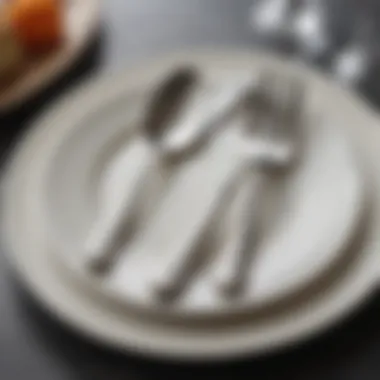Essentials of Choosing Small Flatware Sets


Intro
Flatware is an essential element of any dining experience. Small flatware sets play a crucial role, especially in intimate settings and casual meals. This article delves deeply into the significance of small flatware, focusing on its utility, aesthetic aspects, and the various materials and styles available.
By understanding these essentials, consumers can make informed decisions that enhance their dining experiences. Whether you are hosting a dinner party or enjoying a simple meal at home, the choice of flatware can greatly influence presentation and functionality.
We will explore several important facets related to small flatware sets including considerations for selection, maintenance tips, and current trends in style. Knowing these details will help in creating an enjoyable and stylish dining atmosphere.
This exploration aims to enhance the understanding and appreciation for small flatware, ensuring that you choose the right pieces for your unique culinary context.
Understanding Flatware
Understanding flatware is crucial when choosing a small flatware set. This segment provides insight into what flatware is and its intended use. Grasping these concepts will enhance your appreciation of the functional and aesthetic aspects of any dining experience.
Definition and Purpose
Flatware refers to utensils specifically designed for dining and serving food. It typically includes forks, knives, and spoons. Their main purpose is to assist in the consumption of food, ensuring that the act of eating is both practical and enjoyable. Beyond mere utility, flatware also contributes to the overall presentation of a meal, making it an essential aspect of dining culture.
A well-chosen flatware set reflects the host's style while catering to guests’ needs. From casual dinners at home to formal gatherings, the right flatware enhances any dining experience. Ensuring the selected flatware aligns with the type of meals served can elevate the overall experience.
Difference Between Flatware and Cutlery
The terms flatware and cutlery are often used interchangeably, yet they possess distinct meanings. Flatware encompasses all utensils used at the table for eating, with forks, knives, and spoons being the primary components. On the other hand, cutlery is a broader term that includes not only eating utensils but also other tools used for preparing and serving food, such as kitchen knives and peelers.
Understanding this distinction is important for consumers. People seeking a comprehensive dining experience should focus on acquiring a suitable flatware set, while those engaged in food preparation should look into quality cutlery. Each category serves its specific purpose, but both are integral to the culinary process.
"A thoughtful selection of flatware can transform a meal into a memorable event."
Engaging with flatware extends beyond mere functionality. It invites individuals to consider the atmosphere they wish to create during dining occasions. Making informed choices about flatware can thus significantly enhance one's culinary experience.
Importance of a Small Flatware Set
A small flatware set plays a crucial role in modern dining experiences. It serves not only functional purposes but also adds to the overall appeal of the table setting. In a world where minimalist living is gaining much attention, the significance of these compact sets increases. They are designed to maximize usability while minimizing space, aligning perfectly with today’s lifestyles, especially in urban settings where kitchen and dining space can be limited.
Space Efficiency in Dining
One of the primary benefits of a small flatware set is its ability to save space. In smaller kitchens or dining areas, having a compact set means that each piece is essential, avoiding clutter. These sets often come in well-organized cases or are designed to fit neatly in drawers. When you have limited space, every item must serve its purpose without excess. A small flatware set allows for this efficiency without sacrificing quality or style.
In addition, these sets often include only the most necessary utensils, such as forks, knives, and spoons. This simplicity can lead to a more organized dining experience, making it easier to set the table and clean up after meals. Minimizing the number of items can also help streamline meal preparations and serve as a reminder to focus on the food rather than the presentation of countless utensils.
Versatility in Various Settings
Another notable aspect of small flatware sets is their versatility across different dining settings. Whether you are hosting an intimate dinner, a casual lunch, or enjoying a picnic in the park, these sets adapt easily to various occasions. Their design can complement rustic wooden tables as well as modern glassware, making them suitable for almost any scenario.
In addition, a small flatware set can cater to different types of food, from gourmet dishes to everyday meals. The sleek and simple design allows for ease of use, encouraging diners to engage more with their meals. For example, when serving smaller portions or delicate dishes, having appropriately sized utensils can enhance the dining experience without overwhelming the presentation.
Moreover, many small flatware sets are made from durable materials that can withstand frequent use while maintaining their aesthetic appeal. This durability makes them ideal for both casual dining and formal occasions. In summary, the importance of a small flatware set extends beyond mere utility; it embodies the essence of a practical yet elegant dining experience.
Key Features to Consider
When choosing a small flatware set, several key features play a crucial role in decision-making. Understanding these features helps in selecting flatware that meets both aesthetic preferences and functional needs. Material composition, design aesthetics, and ergonomics are central factors to contemplate. Each element contributes uniquely to the overall dining experience.
Material Composition


Material composition impacts the durability, appearance, and maintenance of flatware. Here, three common materials are explored: stainless steel, silver, and plastic.
Stainless Steel
Stainless steel is a prevalent choice for flatware due to its durability and resistance to rust and corrosion. It can withstand frequent use without losing its finish, making it a practical option for everyday dining. One key characteristic of stainless steel is its strength. This robustness ensures safety during use, as it can handle various foods and dining scenarios.
Unique features of stainless steel include its easy cleaning and maintenance. It is often dishwasher safe, which appeals to busy lifestyles. However, its weight might be a disadvantage for some. Heavier utensils may not be suitable for everyone, especially children. Still, the benefits of elegance and longevity typically outweigh the disadvantages.
Silver
Silver flatware adds a touch of elegance to any dining occasion. Its beauty is unmatched, making it a desirable option for formal settings. Silver's distinctive luster is a key characteristic that enhances table aesthetics.
A unique feature of silver is its hypoallergenic nature, making it ideal for individuals with sensitivities. However, it requires more care than stainless steel. Silver needs polishing to maintain its shine and is often not dishwasher safe. This aspect may deter some from choosing silver for everyday use as it requires more maintenance than others.
Plastic
Plastic flatware is often seen in casual or outdoor dining settings. Its primary advantage lies in its lightweight and disposable nature. Many people find plastic flatware convenient for picnics and parties, as it does not require cleaning and can be discarded after use.
Unique features of plastic include its variety of colors and shapes available in the market. This versatility allows for creative table settings. While convenient, the main disadvantage of plastic is its less durable quality compared to stainless steel and silver. It may not provide the same dining experience and can be perceived as less classy.
Design Aesthetics
Design aesthetics significantly influence the purchase of flatware sets. Two main aspects to consider include traditional and modern designs, as well as color options.
Classic vs. Modern
Classic designs convey elegance and timelessness, while modern designs often feature minimalist aesthetics. Choosing between these styles can reflect personal preference and dining context.
Classic flatware often showcases intricate designs and patterns, contributing to a formal appeal. It is popular for special occasions. In contrast, modern flatware may emphasize clean lines and functional aspects, aligning well with contemporary dining experiences. A disadvantage of classic options may include higher price points and more care during maintenance. Modern style, while sleek, may lack some of the charm associated with classic designs.
Color Options
Color options add an extra layer of personalization to flatware sets. They enable individuals to match their flatware with table decor, enhancing overall presentation. Popular colors include metallic tones such as gold and rose gold, which offer a contemporary twist to traditional silver.
A unique feature of colored flatware is its ability to transform a dining experience. It can make an event feel more festive. However, color choices may sometimes fade with usage, especially if they are lower quality. Selecting quality colored options can ensure longevity without compromising aesthetics.
Ergonomics and Usability
Ergonomics and usability are vital in determining the comfort of a flatware set. The design should allow for easy handling while maintaining effectiveness during use. Features such as weight, handle design, and overall shape play roles in how comfortable and functional the flatware is.
A well-balanced flatware piece enhances user experience, providing comfort during extended use. Proper grip should allow users to maintain control without excessive strain. As a result, incorporating ergonomic designs can significantly contribute to user satisfaction. Some designs may prioritize aesthetics over usability, leading to discomfort during meals. This aspect demands careful consideration when selecting a flatware set, ensuring that comfort does not take a backseat to style.
Types of Small Flatware Sets
Understanding the types of small flatware sets is crucial for anyone looking to enhance their dining experience. A well-equipped flatware set can significantly improve mealtime by providing the proper tools for various foods. Additionally, having an assortment of utensils allows for versatility, whether dining at home or entertaining guests. Each type of flatware serves a specific purpose, contributing to the overall functionality and elegance of a table setting.
Eating Utensils
Forks
Forks are one of the most fundamental pieces of flatware. Their primary function is to help in lifting food to the mouth, making them essential during meals. The typical fork design features four tines, allowing for effective piercing and scooping of food items. What makes forks a popular choice is their adaptability; they can be used to eat many dishes, from salads to main courses. A unique aspect of forks is the variation in design, such as dinner forks, salad forks, and dessert forks, each tailored for specific foods. One disadvantage is that forks can become less useful with certain foods that require cutting, where a knife would also be necessary.
Knives
Knives play a vital role in the flatware set. Their primary function is to cut food, which is especially significant for meats and harder vegetables. The typical dinner knife design includes a curved blade that helps in slicing through various textures. A key characteristic of knives is their versatility; they can often double as a spreading tool for butter or other spreads. Unique design features, such as serrated edges on steak knives, offer enhanced cutting ability. However, an issue can arise when soft foods become squished instead of sliced, indicating a quality knife is crucial for optimal performance.


Spoons
Spoons are indispensable in any flatware set, allowing for consumption of liquid and semi-liquid foods. They come in various forms, notably soup spoons, dessert spoons, and teaspoons. The design of a typical spoon includes a rounded bowl at the end, facilitating easy scooping. Spoons are a beneficial choice as they are useful across various meals, whether eating cereal, soup, or desserts. A unique feature of spoons is their size differentiation, catering to different types of dishes. One consideration when selecting spoons is the potential for less effective use with solid foods, where forks might be more appropriate.
Specialty Flatware
Dessert Forks
Dessert forks are specifically designed for consuming sweet dishes. Typically smaller than dinner forks, they often have shorter tines and a broader handle, allowing for lighter and more delicate desserts. A notable aspect of dessert forks is their design; many come with unique patterns or finishes, enhancing the dining aesthetic. These forks are a beneficial choice for formal gatherings and can elevate the overall dining experience. One disadvantage might be their limited function—they are not as versatile as larger forks, primarily suited for sweet treats only.
Salad Knives
Salad knives are a distinctive addition to flatware, meant for cutting through leafy greens and softer vegetables. Their blades are not as sharp as dinner knives, prioritizing a safe cutting approach. The key characteristic of salad knives is their design, often with a serrated edge to enhance the cutting of fragile ingredients. They serve a specific purpose during meals involving salads, making them a valuable addition to any table setting. However, one limitation is that they may not be suitable for tougher foods, reducing their overall functionality compared to multi-purpose knives.
Child-Friendly Options
When considering flatware options for children, safety and usability become key factors. Child-friendly flatware typically features rounded edges and smaller sizes, designed for little hands. Bright colors and fun designs on utensils can encourage children to engage with their meals. The use of lightweight materials can enhance comfort during meals. However, it is important to ensure the sturdiness of the utensils to withstand the handling by energetic children.
Emphasizing the types of small flatware sets ensures a greater understanding of how each piece contributes to the overall dining experience. Each utensil and specialty piece offers functionalities, enhancing the practicality of every meal.
Sourcing a Small Flatware Set
Sourcing a small flatware set is a significant step in the pursuit of creating an optimal dining experience. The choices available can vastly impact not only the aesthetic appeal of your table but also the functionality and enjoyment of meals. Understanding where to find these sets is essential for making informed decisions.
Retail Options
Physical Stores
Shopping in physical stores offers the opportunity to interact directly with the products. You can feel the weight of the flatware, examine its finish, and assess the design in person. A notable quality of physical stores is the immediacy of the purchase; you can take your flatware home right away. This can be particularly beneficial for last-minute gatherings or when you need a quick replacement.
However, physical stores might be limited in selection. Specialty shops may carry higher-end or unique designs, but they can also result in higher price points. This limitation means that shoppers may not always find precisely what they want on the spot.
Online Marketplaces
Online marketplaces provide an extensive array of options, often featuring a vast range of styles and prices. They allow consumers to compare different brands effortlessly. A primary benefit of online shopping is convenience; you can browse a wide selection from the comfort of your home at any time. Popular platforms like Amazon or eBay often have user reviews, which assist in evaluating product quality and customer satisfaction.
However, purchasing online can come with disadvantages. The inability to see, feel, or test the flatware is a significant drawback. There can also be issues with shipping times, which can delay your ability to set your table as planned. Be sure to check for return policies to manage dissatisfaction or sizing issues.
Brand Considerations
When choosing a small flatware set, brand reputation plays a crucial role. Established brands like Oneida or Mikasa often have a history of quality and durability. Exploring customer reviews and industry awards can provide insights into their standing in the market. Moreover, some brands focus on sustainability, offering environmentally friendly options which may appeal to conscious buyers. Ultimately, weighing the characteristics of various brands will help you select a set that aligns with your dining needs and personal values.
Caring for Your Flatware
Caring for your flatware is an essential topic that affects not only the longevity of your utensils but also their appearance and functionality. A small flatware set is an investment in your dining experience, which makes its proper maintenance crucial. Understanding how to clean, store, and maintain flatware can prevent wear and tear, ensuring that your set remains in excellent condition for years to come.
Cleaning Essentials
Regular cleaning of flatware helps remove any residue that can lead to tarnishing or even corrosion, especially in metals like stainless steel. It is essential to wash your flatware after each use. Here are some effective cleaning techniques:
- Hand Washing: Use a sponge or a soft cloth with mild dish soap. Avoid steel wool, as it can scratch the surface. Rinse thoroughly in warm water.
- Dishwasher Use: If you prefer the convenience of a dishwasher, place your flatware in the designated area. Ensure that knives and other sharp utensils are positioned blade-down to prevent damage. Select a gentle cycle and avoid high-temperature wash cycles to protect the finish.
- Drying: Never air dry your flatware. Instead, use a soft towel to dry each piece promptly. This prevents water spots and rings from forming.
Storage Solutions


Storing flatware correctly is vital to maintain its condition. Storing utensils loosely can cause scratches, while overcrowding them may lead to bending. Some effective storage methods include:
- Flatware Trays: Invest in a compartmentalized tray to keep utensils organized. This will also help avoid contact between pieces that can cause scratches.
- Drawers: If you choose to store flatware in a drawer, consider using drawer liners to protect them from scratches and damage. Keep flatware separate based on type to prevent mix-ups.
- Containers: Store reserved sets or specialty flatware in containers to keep them dust-free. Consider fabric wraps for additional protection.
Preventative Maintenance
Addressing maintenance proactively can extend the life of your flatware. Here are some suggestions for preventative care:
- Routine Checks: Regularly inspect your flatware for any signs of wear or damage. Early detection can prevent further issues.
- Polishing: For silver flatware, occasional polishing is necessary to keep the shine. Use a suitable polish and a soft cloth.
- Avoiding Acidity: When serving acidic foods, such as salads with vinegar or citrus dressings, serve with utensils designed to withstand acidic reactions. This protects the metal from discoloration.
Proper care ensures your flatware remains a source of pride during any meal.
Taking these steps seriously demonstrates a commitment not only to your personal table setting but also to the culinary experiences shared with family and friends. With a little effort, your small flatware set can continue to impress for many occasions.
Trends in Flatware Design
Understanding trends in flatware design is crucial when selecting a small flatware set. As dining experiences evolve, so too does the flatware that accompanies them. These trends not only reflect changing aesthetic preferences but also manifest in practical innovations that enhance usability. Consideration of current designs can elevate a dining setting, making it more enjoyable and efficient.
Emerging Materials
Emerging materials in flatware design are shaping the dining landscape significantly. One notable trend is the rise of biodegradable materials. These resonate well with eco-conscious consumers seeking to reduce their environmental footprint. Materials like bamboo and certain composites offer an alternative to traditional stainless steel or silver. They are lightweight, making them a convenient choice for casual dining or outdoor events. However, durability must be considered, as they may not withstand heavy use like their metal counterparts.
Another material gaining popularity is high-performance titanium. It offers immense strength while being lightweight. This makes it appealing for both home use and travel. Titanium is also resistant to corrosion and scratches, ensuring it retains its appearance over time. Nonetheless, it can be more expensive, which could deter budget-conscious buyers.
Innovative Designs
Innovative designs have the power to redefine how flatware is perceived and used. One trend is the shift towards ergonomic shapes. Flatware designed with user comfort in mind can lead to a more pleasant dining experience. Forks with curved handles or knives with carefully considered grips reduce strain and enhance functionality, especially for individuals with dexterity issues.
Sustainable Options
Sustainable options in flatware design address both aesthetic and environmental concerns. The use of recycled metals is increasingly common, appealing to those seeking to support sustainability in their purchasing decisions. One key characteristic of sustainable options is their minimal carbon footprint in production. Choosing recycled materials not only lessens environmental impact but also often showcases unique finishes that traditional metals may lack.
Another popular sustainable choice includes flatware created from renewable resources. These sets often feature natural finishes, elevating the dining experience. While they can be more expensive in terms of initial cost, the long-term benefits include greater durability and reduced environmental harm.
Customizable Sets
Customizable sets offer personalization that resonates in today’s market. Consumers increasingly desire items that reflect their personal style. A big attraction of customizable flatware sets is the ability to select specific pieces within the set. This means that individuals can mix and match utensils that best suit their dining preferences. They can choose varied styles and sizes, allowing for a more tailored experience.
Customizable sets also often include options for engravings or monograms, adding a personal touch that can make dining more special. The main disadvantage lies in potentially higher costs and longer wait times for personalized items. Yet, the ability to create a unique flatware collection often outweighs these minor drawbacks.
"The flatware of the future is more than just functional; it reflects individual values, sustainability, and contemporary design."
In summary, trends in flatware design are vital in informing consumers and guiding their choices. By embracing emerging materials and innovative designs, as well as the option for personalization, buyers can select small flatware sets that align with their dining needs and lifestyle.
Epilogue
The conclusion of this article serves to encapsulate the essence of a small flatware set and its relevance in today’s dining culture. Small flatware sets are not merely functional items, but they also reflect personal taste and dining style. Emphasizing their efficiency, one can appreciate how these sets optimize space without compromising on elegance or utility.
Moreover, understanding the various materials, designs, and care tips offers clarity in selecting the right flatware that suits individual needs. For instance, stainless steel is often favored for its durability and low maintenance, while silver might be chosen for formal occasions.
"Selecting the right flatware reflects one's culinary preferences and enhances the overall dining experience."
In making informed decisions, considerations such as ergonomics and versatility can also enhance user experience. Ultimately, knowledge about small flatware sets not only empowers consumers to choose wisely but also contributes positively to the dining experience they wish to create in various settings, be it casual or formal.
Final Thoughts
In closing, the exploration of small flatware sets highlights their significant role in dining. These sets complement meals, whether shared with family or friends. They contribute to the aesthetic appeal of any table setting. When selecting a flatware set, understanding one’s needs and preferences is crucial for satisfaction. Overall, investing in well-made, versatile flatware can enhance both everyday meals and special occasions.
Encouragement of Informed Choices
There is value in making informed choices when it comes to flatware. Consumers should take the time to research and consider options available in the market. From various materials to thoughtful designs, every choice impacts both functionality and visual appeal. By assessing personal dining habits and preferences, individuals can select a small flatware set that truly resonates with their lifestyle. Such decisions lead to a more satisfying dining experience.







